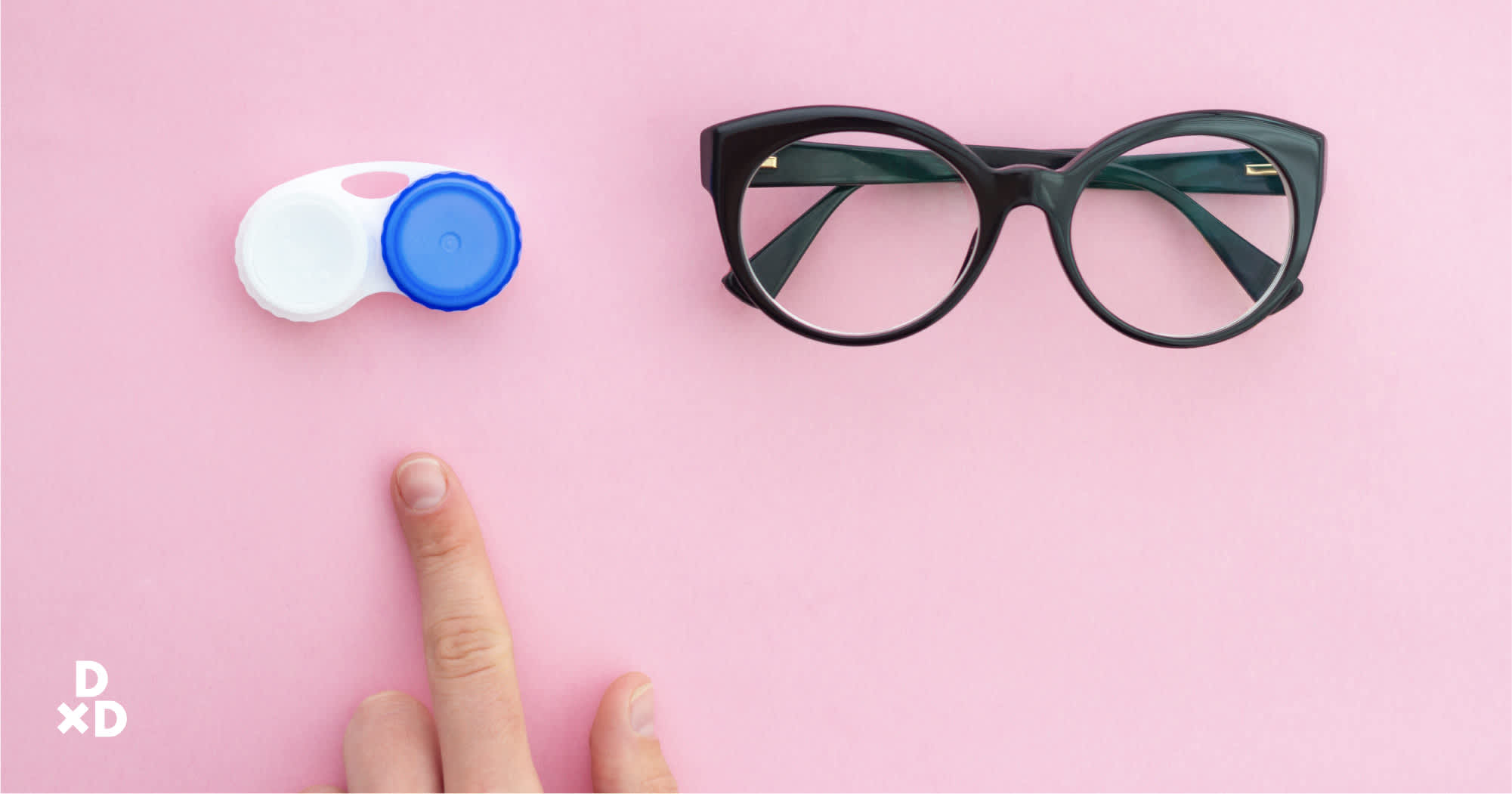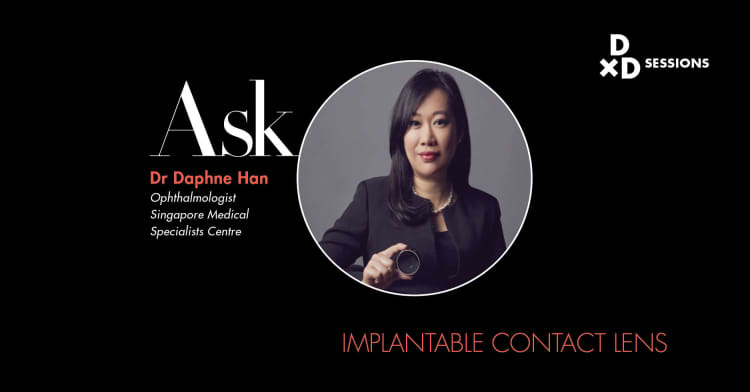Singapore is often dubbed the “Myopia Capital of the World”. With the current trend of myopia in Singapore, it is estimated that 80 to 90% of all Singaporean adults above 18 years old will be myopic with 15 to 25% of them possibly suffering from high myopia. [1]
Myopia has three grades of severity [2]:
- Low myopia : -0.50D to -2.99D
- Moderate myopia : -3.00D to -4.99D
- High myopia : -5.00D or less
The more negative the refractive error value, the stronger the prescription needed for your glasses or contact lenses if you decide to have them.
In this article, we’ve enlisted the help of experienced ophthalmologist, Dr. Daphne Han, to share with us how to manage and deal with eye conditions like high myopia. Learn all about how high myopia works, its symptoms, its treatments, their costs, possible complications and useful lens technology to slow down myopia progression.
What exactly is high myopia?
Having myopia, also known as nearsightedness or shortsightedness, means that far objects appear blurry when looked at. During an eye test, a normal and unaffected eye can see the alphabets clearly from 6 metres away, while a highly myopic eye can see only as short as 1 metre away.
As mentioned before, high myopia refers to an optical power of -5.00D or less, which is more commonly known in Singapore as upwards of 500 degrees. A lot of people have such a degree of high myopia in Singapore. In fact, there is a move to reclassify high myopia to above 1000 degrees in Singapore, which is pretty staggering.
There are usually some accompanying symptoms to high myopia [3].
What are the symptoms of high myopia?
- Blurred vision
- Squinting
- Eye strain, eye fatigue from prolonged squinting
High myopia will definitely affect your daily lifestyle if you do not find the proper treatment, such as getting a pair of spectacles or contact lenses.
But first, how exactly does high myopia come about?
What are the causes of high myopia?
Such conditions like high myopia occur due to your eyeball growing too long or the cornea becoming too curved. Think of a balloon inflating more and more, growing into an oversized oblong shape.
The light does not hit the retina of your eye properly, making images seem blurry.
The reasons behind your high myopia could be by choice or by chance, perhaps brought about by bad eye care habits or written into your genetic code.
Heredity
Myopia can be caused by what is in your DNA. If one of your parents is myopic, the risk of you becoming myopic is twice as high. It is more likely so if both of your parents are myopic. [4]
Lifestyle practices
In many cases, high myopia is a condition that develops and worsens from young. In Singapore, many children have developed myopia due to extensive exposure to activities that require visual focus on nearby objects. This includes constantly using handheld devices and computers or reading, usually in an indoor setting.

What are the possible complications of high myopia?
The eyeballs of a highly myopic child continue to grow into the oblong shape instead of a normal round one. This puts him or her at risk of many eye disorders later in life, such as early cataracts, glaucoma, macular degeneration, and retina detachment.
These complications often cause significant morbidity and may even pose danger to your ability to see.
Taking the necessary steps to curb the progression of myopia is paramount to avoid such complications of high myopia.
Myopic macular degeneration
As the eyeballs of a myopic person grow, the elongation of the eye causes stretching and thinning of the retina.
That is especially so at the center of the retina, called the macula. That region is where there are a lot of photoreceptors and nerve endings to let you see clearly.
Damage to the macula can potentially lead to loss of sight if left untreated. [5]
Retinal detachment
If the retina is stretched too much, it may start to develop tears or holes, and detach from its base. This can cause irreversible blindness if left untreated.
Glaucoma
The pressure in the myopic eye can affect the optic nerve, causing stress and damage to it. Likewise, it can cause blindness when the disease manifests in your old age.
While high myopia is a possible precursor to glaucoma, the eye disease of glaucoma is in itself a hereditary condition. It can be passed down from your parents too.
Cataracts
A cataract is a clouding of the clear lens in the eye. Cataracts in those with high myopia can be very dense, leading to a decrease in vision, faded images, and halos.
Can high myopia be reversed or corrected?
High myopia cannot be reversed entirely. Once the myopic eye has grown into its elongated form, its shape cannot be changed.
Though its elongated anatomical structure is irreparable, the eye’s focusing power can be corrected. This may be by spectacles, contact lenses or refractive eye surgery. In refractive surgery, the focusing power can be reduced by changing the cornea curvature at the front of the eye, allowing the light to hit the retina to form a clearer picture.
As the saying goes, prevention is better than cure — and in this case, it’s no different! It’s very important to start managing myopia as early as possible to prevent it from getting worse.

When to start managing myopia progression?
Management of myopia progression should start in childhood and teenage.
Research shows that myopia progression can be very rapid during the early ages of 6 to 14 years old, which would then be the most crucial time to manage myopia.
Beyond the teenage years, the eyes would have reached a mature phase and by then, not much can be done to influence the development of the eyes.
From the day the child is born, their eyes develop as they grow. In general, at about 2 years old, the growth of eyeballs would have naturally stabilised already. However, due to our genetics, lifestyle and environment, the eyeballs are affected by these factors and do not actually stabilise in growth.
In all preschools in Singapore, the children already undergo tests for their eye health from about 2 years old onwards. This will reveal if there are any blurry vision from conditions like myopia or astigmatism as well so that the family can take the necessary treatment actions.
The next 15 years is the crucial time frame to muster all efforts to take proper care and manage the myopia progression.
How to prevent myopia progression?
For any degree of myopia, especially high myopia, prevention really is better than cure! The best way to treat myopia is to prevent its progression beforehand.
There are some effective habits to adopt to curb myopia progression. The treatment route would be best decided by your trusted optometrist or ophthalmologist.

Outdoor activities
Believe it or not, spending time doing outdoor activities is one of the best ways to slow down myopia progression and avoid high myopia! Many studies showed that outdoor activities can stabilize eye growth and suppress myopia progression and hence lower the risk of high myopia [6] [7]
Once your child starts primary school, there will be an increase in the intensity of near work such as reading, studying, and writing. It is highly recommended to accommodate a few hours a day for your child to spend some time outdoors to exercise and play. Even just reading a book outdoors is better than doing it indoors!
There is also the benefit of being exposed to natural sunlight, which contributes to Vitamin D production in our body as well, instead of the artificial lighting used indoors when doing near work. [8]
Atropine eye drops
Atropine eye drops have been prescribed to slow down myopia progression in children since the 1960s. They work by relaxing the focusing muscles in your eye which can influence myopia progression.
However, there may be side effects for some users such as glare and blurry vision, if higher concentrations are used.
Ortho-K lenses
Orthokeratology lenses are special gas permeable contact lenses that can be worn to reshape the curvature of the cornea. It works by fitting on the surface of the eye and applying slight pressure, moulding the cornea curvature to refocus the light onto the retina properly.
It is worn overnight while your child sleeps and has been found to slow down the progression of myopia.
Of course, contact lenses come with their own shortcomings as well — that being possible contamination. Proper lens care is paramount to prevent introducing foreign bodies to the eye that could lead to infection. Therefore, if you consider this as an option, it is important to teach your children proper lens care and to practice good hygiene religiously.
HOYA MiYOSMART lenses
Myopia control lenses are special lenses that are worn as spectacles. One of these is the HOYA MiYOSMART lenses. HOYA Vision Care, together with its research collaborator, has worked on this innovative lens technology and myopia research to come up with a novel myopia control lens product.
Research showed that HOYA MiYOSMART lenses are specially engineered lenses that have been very effective in slowing down myopia progression and even potentially stopping it. [9]
How is high myopia treated in Singapore?
The early childhood to teenage phase of your life is the most effective time frame to prevent myopia progression. If your efforts to curb myopia progression have not been sufficient, you may get high myopia.
After that time frame, there is not a lot that you can do to reverse the effects and higher risks of other eye diseases like cataract, glaucoma and retina detachment, except for refractive correction. Here are some ways to manage high myopia in Singapore.
Spectacles
A very common way to deal with high myopia is to get a prescribed pair of spectacles. It is the most accessible and easy-to-use method for most people in Singapore.
Contact lenses
Another common way to deal with high myopia is to use contact lenses.
There are obvious inconveniences that come with using contact lenses such as maintaining, changing and putting them on.
Surgery
Visual correction procedures, such as LASIK, directly changes the curvature of your corneas to adjust the focusing length and thereby correcting your vision. This helps achieve a more natural outcome, since you no longer have to wear any external visual aids.
If you are highly myopic with 1000 degrees (-10.00D), and your cornea is thick enough, you may possibly undergo LASIK for high myopia to perfect vision successfully. If your cornea is not thick enough, then LASIK may not be able to provide correction for the full power. If you insist on LASIK in such a scenario, you may only undergo LASIK to correct your vision to a lower degree of myopia.
An alternative to LASIK in these cases is the Implantable Contact Lens (ICL). In this surgery, myopia up to -20.0D (or two thousand degrees) can be treated. However, this surgery has its own pros and cons and just like for LASIK, not everyone is automatically suitable for it. In general, LASIK and ICL surgeries give better results for lower degrees of myopia than high myopia.
These may seem like more expensive options to deal with high myopia to some. However, comparing the high upfront cost of surgery to the cost of other external visual aids over time, it may not seem to cost that much more.
Plus, it is so much more convenient after surgery compared to wearing the other visual aids.
With these surgical procedures, you have a chance of waking up from your naps and seeing clearly immediately!
What is the difference between Single Vision Lenses and Myopia Control Lenses?
As the name implies, Single Vision spectacle lenses only have one focusing point along the entire surface of the lens. When you shift your gaze from far to near, the focusing point on the lens is not adjusted for you. Instead, your own eye focusing muscles have to adjust to get a clear image.
On the other hand, Myopia Control lenses such as MiYOSMART, the multifocal or progressive glasses help to relieve the stress on the eye muscles. There are different areas of lower power on these lenses which can help reduce the eye strain when shifting gazes from far to near, and in the process lowering myopia progression.
Why use HOYA MiYOSMART lenses to manage myopia progression?
Since the 1900s, Hong Kong Polytechnic University's Optometry School has been researching myopia. They wanted to create some form of vision aid for children that are easy to wear, unlike special contact lenses which may be uncomfortable and require high maintenance. They moved into the idea of creating a pair of glasses, which they then approached HOYA.
Hong Kong Polytechnic University and HOYA collaborated to design and test this innovative lens technology to manage myopia progression. It was introduced to markets in China and Hong Kong since its public inception for about one and a half years.
HOYA MiYOSMART lenses have given very promising results in double-blinded studies and clinical trials conducted over two years. [9] HOYA MiYOSMART lenses have outperformed other myopia control lenses in slowing down childhood myopia progression. [9] They have also been able to keep up with the efficacy of myopia control in comparison to ortho-k lenses and become comparable to atropine eye drops.[9]
Worn just like your everyday glasses, HOYA MiYOSMART lenses offer a great, hassle-free solution to managing myopia progression, compared to other options like using atropine eye drops and ortho-k lenses daily.
How exactly do HOYA MiYOSMART Lenses slow down progression of myopia?
While there are numerous types of myopia control lenses on the market that work on similar principles, HOYA MiYOSMART lenses hold an innovative edge with their Defocus Incorporated Multiple Segments (D.I.M.S.) technology, based on the myopic defocus theory.
Quite a mouthful, but it can be easily broken down.
Basically, there are about 400 little “dots” or defocus segments on the special lenses that are individually engineered to create a myopic defocus.
When your child is looking through those segments in the lenses, the myopic defocus created helps to slow down the myopia progression and elongation of the eye.
A loose analogy for how it works could be a tug-of-war. While the child’s eye is naturally focusing on a point and the eye grows longer due to the myopia condition, the intentional myopic defocus of the segments helps the eyes to “pull away” from the elongation effect to some extent.
This lens technology helps to alleviate the stress on the eye when looking at nearby objects and thereby slowing down the progression of myopia and preventing high myopia.
What are the costs of myopia control options and high myopia treatments?
Ortho-K lenses can cost upwards from $1,800 over two years. Low dose atropine eye drops can cost less than $20 for a month excluding cost of spectacles ($480 over two years). This is not inclusive of the fees for the eye test and doctor’s consultation beforehand.
HOYA MiYOSMART lenses retail at $530 a pair. It also includes a complimentary pair of lenses with the MiYOSMART Assurance Program as HOYA understands the likelihood of children misplacing and breaking their belongings (terms and conditions apply).
Vision correction treatments like LASIK are very safe procedures that can cost upwards of $3,500.
However, if you do not fulfill some anatomical prerequisites for LASIK such as cornea thickness, you can look to Implantable Collamer Lens instead which costs about $10,000.These surgeries, however, should last you a good 20 to 40 years, depending on at what age you have them done, and how well your eyes age over the long term.
How is high myopia diagnosed?
It is a pretty easy process. Just like going for any visit to the optometrist, there will be a simple refractive error test to determine the eye power. This includes looking through the autorefractor machine at the optometrist and the Snellen chart test with the alphabets of varying sizes.
For a more complete examination, there could be a more holistic eye check that focuses on the retina. As mentioned earlier, patients with high myopia tend to have a thinner retina and elongated eyeballs. There would be points of weaknesses in the eye since the retina is more stretched out and exposed to tears and detachment. Glaucoma screening could also be on the list.

What are some good practices to employ for high myopia?
Firstly, you can go to a qualified optometrist or eye clinic for your eye checks.
Having regular eye checks is quite important. Ideally, this should be once a year to ensure that there are no huge changes, even for non-serious cases of myopia.
It is also paramount not to over or undercorrect for your vision. Your trusted qualified optometrists will make sure of this.
If your child is experiencing myopia that is progressing at an unusually rapid pace, especially for a young patient with a family history of high myopia, we recommend a check with an eye doctor (ophthalmologist).
The eyes of younger children may be quite tense and an eye doctor is better equipped to unearth the underlying issues in the eye, by performing a cycloplegic eye power test with the use of relaxing eye drops.
Conclusion
The eyes are essential and delicate organs of the body and require the best care to prolong their health. High myopia is a serious condition that can be treated, but prevention is always better than cure. Slowing down the progression of myopia is key to achieving that.
If you have any other questions, let Dr. Daphne Han know at Human’s Ask A Doctor page!











